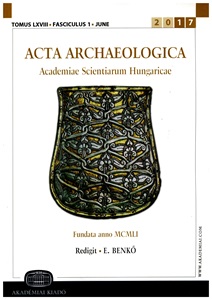FRÜHAWARENZEITLICHE BESTATTUNGSSITTEN IM GEBIET DER GROSSEN UNGARISCHEN TIEFEBENE ÖSTLICH DER THEISS. ARCHÄOLOGISCHE ANGABEN UND BEMERKUNGEN ZUR GESCHICHTE DER REGION IM 6. UND 7. JAHRHUNDERT
Early-wartime burials took place in the area of the Great Hungarian Plain east of the Tisza. Archaeological information and remarks on the history of the region in the 6th and 7th centuries
Author(s): Gábor LőrinczySubject(s): Archaeology, Cultural history, Customs / Folklore, Ancient World, 6th to 12th Centuries
Published by: Akadémiai Kiadó
Keywords: burial practices; Early Avar Age; first generation; Szegvár; Trans-Tisa region; Kutrigurs;
Summary/Abstract: The study discusses and presents the archaeological phenomena of burial practices observed in the graves of the Early Avar Age cemetery of Szegvár-Oromdűlő. Besides orientation, these are the three types of differently formed graves, the stumped variant of fractional animal burials, the spatial separation of the deceased and the accompanying animal remains, and the custom of interring pottery and bone-in meat (lamb rump bone) into graves. It analyses these important but so far not thoroughly exploited groups of sources in regard of the 6th–7th century burials of a larger geographical unit, the Trans-Tisa (Tiszántúl) region, since the population of this region can be better characterized by their funerary practices than their tangible cultural heritage. In addition, it refers to the presence or absence of these characteristics in the burials of a smaller area within the investigated region – the territory bordered by the Körös, Tisza and Maros Rivers – dating to the second half of the Avar Age, and through this, to their continuity. It delineates the grave goods of female and male burials which represent the inheritance of the first generation among the graves of the Trans-Tisa region. Their common feature is their different provenance. Thus there are grave goods with Eastern European, steppe connections, grave goods of Byzantine taste or origin, as well as grave goods of local, Gepidic provenance among them. Communities of the Trans-Tisa region in the 6th–7th century Carpathian Basin are characterized by a chain of significant archaeological phenomena of burial customs exclusively attributed to them, which were commonly spread within a certain area and continuously practiced for generations. Based on these features, the population that settled here can be well outlined in respect of origin, traditions and cultural affiliation. In the author’s opinion it can be presumed by the sparse reports of Byzantine sources that this region was occupied and inhabited by a population referred to as Kutrigurs by contemporary sources and steppe people led by them.
Journal: Acta Archaeologica Academiae Scientiarum Hungaricae
- Issue Year: 68/2017
- Issue No: 1
- Page Range: 137-169
- Page Count: 33
- Language: German
- Content File-PDF

